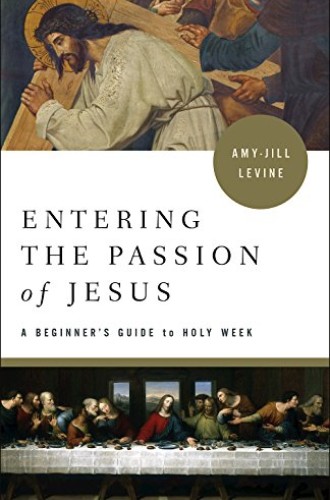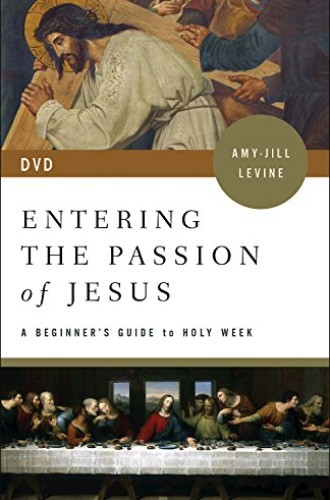Dismantling anti-Jewish readings of the Passion story
Jesus, Amy-Jill Levine reminds us, was a Jew.
"We might think of Jesus' triumphal entry as a victory parade, when the enemies have been conquered, when the liberator has entered. . . . But instead of a victory of dead bodies and booty, what we have instead is the victory of the cross and then the resurrection." It’s one thing to see words like this on the page as you’re reading the chapter assigned for this week’s session of your Lenten book group. It’s another thing altogether to hear them directly from the mouth of Amy-Jill Levine, who radiates passionate, gentle authority as she stands in the archway next to a chapel and looks straight into the camera.
Levine’s new Lenten study book is good. I’d even say it’s pretty great. Not because it achieves the perfect balance in speaking both to beginners and to seasoned readers of scripture (it doesn’t), and not because it covers every aspect of the gospels’ versions of the Passion that’s worth covering (what six-session study guide meant for congregational use could?). But it's an engaging, solidly-written close reading of the Passion narratives that situates Jesus within his Jewish context while deftly dismantling anti-Judaic presumptions, and that alone makes it the kind of book I wish all Christians would read.
Levine, a Jewish professor of New Testament at Vanderbilt Divinity School, regards the Passion narratives as powerful literature that convey the beauty and wonder of the gospel. “Even though I am not a Christian,” she writes, “I have seen it work, over and over again, in my Christian friends, students, and churches worldwide.”
If you’re looking for it, you can glimpse this sense of wonder in the book. In the accompanying DVD, though, it’s undeniable—and it’s riveting. The six sessions, each around eight minutes long, take the book’s content as a jumping off point and then delve into topics that are likely to engender lively discussion. How would Mary Magdalene respond if she learned that theologians in the fifth century created the story that she was a prostitute? Should we come to the Lord's Supper if we're harboring a grudge against a fellow parishioner? (You can watch the first of the sessions here.) Levine’s fascination with Jesus is apparent in her gestures, her facility with Christian theology, her facial expressions, and even the tone of her voice. That fascination gives her credibility as an interpreter who just might have something fresh to say to the church.
In Session Three, for example, she says bluntly about Jesus’ conversation with the scribe about the greatest commandment, “Jesus was right, and his fellow Jews would have agreed.” You watch her say these words, and you believe her. Is it because she’s just recited (in Hebrew) the scripture that Jesus quotes to the scribe, noting that those verses are a part of Judaism’s daily liturgy and she remembers saying them as a child? Is it because she’s consistently shown in the two prior sessions that Jesus’ beliefs aren’t as opposed to the Judaism of his day as Christians often make them out to be? In either case, that unspoken assumption you inherited from your theological forebears—the idea that first-century Jews cared about laws more than love—is shattered.
By making the Judaism of Jesus recognizable—even familiar—to Christians, Levine does important work for Jewish-Christian relations. But she also has a lovely way of making unrecognizable those elements of early Judaism that Christians falsely assume to be similar to their own experience. Describing the temple in Jesus’ time, Levine says, “You have people from all nations, children crying out, tourists marveling at the buildings, the squawks and the bleats of the animals, the vendors selling their wares, the pilgrims delighted to be there, and some army representatives from Rome standing there as well. This is not a place of calm and quiet.” Hearing her say these words as she stands in the aisle of a calm and quiet chapel, suddenly you get it. When Jesus turns over the tables in the temple, it’s not like he’s storming into a Sunday morning church service at 11 a.m. Something different is going on.
Both the book and the DVD make it clear that studying the Passion stories in their original context—Jewish faith, Roman occupation, Greek words, and all—can help us feel more connected to them. Their questions, their risks, and their failings become our questions, our risks, and our failings. The story of the widow’s mite, Levine writes, “asks what we think we should be doing with our money, and what we should be doing with our time.” But it also asks us to notice who we are seeing and who we aren’t seeing. It challenges us to hold our gaze rather than look away when we see someone whose next meal may be uncertain. The story of the Last Supper reminds Christians that our participation in holy communion is a participation in a Passover, a feast of freedom. So we should be asking ourselves the question: “from what has God set us free?”
“The gospels look like they don’t quite know what to do with Judas,” Levine admits in DVD Session Five. “And neither do I, and neither should we.” However, she says, the story of Judas continues. His name “literally means ‘Jewish man,’ or ‘man of Judah.’ So through the centuries, Judah came to represent the Jewish people. And that was not good for the history of Jewish-Christian relations.” His story also continues for all those who are affected by suicide, she contends, suggesting that we regard the biblical figure of Judas through a hermeneutic of compassion.
Levine’s fierce sort of gentleness in moments like this can be disarming. As I watched her make this final point about Judas, I was still caught up in her prior point about the etymology. I was still asking: Have I ever conflated my judgment of Judas with my feelings about Judaism? As I pondered this question, hearing Levine invoke the language of compassion both raised the stakes of my answer and reminded me that where I have erred, I still have the chance to do better.
I experienced this same dual sensation—something like repentance and forgiveness—as I watched Levine talk about the Gethsemane story in the final session. The insiders, she notes, the very disciples who’d witnessed the Transfiguration, fell asleep when he asked them to stay awake. In contrast, those who showed him the most loyalty were outsiders: the woman who anointed him, the centurian. And then she drives her point home: “The gospels ask: Are you an insider? Are you an outsider? Have you failed? Have you remained true? And if you have failed, if you have fallen asleep, recognize that there’s still a continuation of your story as well.”







